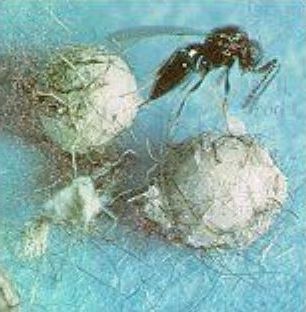|
Trichogramma Wasp
View more pictures: Bing Images Google Images Yahoo Images Common names: Trichogramma Wasp Scientific name (Family): Trichogrammatidae Region: Throughout North America and Europe Life cycle: Very prolific. Many generations per year. Physical Description: Harmless to humans and animals. They are less than 1/32 of an inch long, and are not likely to be seen or collected except as a result of caging parasitized eggs and observing them with a lens. They are black, brown, or yellow in color. The wings are margined with hairs. The greatest width of the body is at its eyes. The entire immature life is spent within the host egg. The commercially available Trichogramma Wasps are: Trichogramma evanescens - Best used in Orchards Trichogramma minutum - Best on trees and in orchards where the protective zone is five feet or more above ground level. Trichogramma platerni - Best for avocado groves and orchards. Trichogramma pretiosum - Best in vegetable gardens where the protective zone is five feet or less above ground level. Feeding characteristics: These tiny wasps are parasites inside the eggs of other insects. They parasitize eggs on up to 200 insect pests, including the eggs of the following: Aphids They lay one to fifty eggs in single host egg, which then terminates development. The host egg will turn black. The larvae feed on the egg and emerge as an adult. Females normally outnumber males depending on the availability of food. A European and Australian species actually swims underwater in order to place their eggs in those of aquatic insects. The adults feed on the nectar from the flowers of weeds and flowers of the daisy (Chrysanthemum) and carrot (Umbellifers) families. It is important to make three separate releases at two-week intervals. This way the tiny wasps will have a chance to catch the pest at the most vulnerable stage of their life cycle. They are very effective, because of their astounding rate of increase.
Purchase Trichogramma-Wasps at Organic Garden eStore.
Return from Trichogramma Wasp to Insects Q-T Encyclopedia of Garden Insects |
